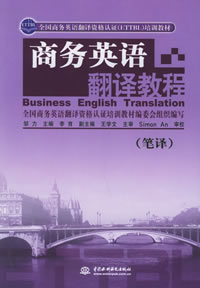Ever-Changing English: A Translator’s Headache
作者:古龙 2009-07-04




语际翻译公司 转载请注明https://www.scientrans.com
∗本栏目部分文章内容来自互联网,部分已经过本站编辑和整理,如有版权事宜请联系Email/MSN jesczhao@hotmail.com
Then there is the usage in a situation of elements that are not subsets of each other, as in the instruction “place on a table and/or rack.” Here the issue is really of a physical impossibility: you cannot place the same object on a table and a rack at the same time. I could give many more examples, but what I am trying to emphasize is that the translator is faced with a real problem, not just a stylistic quibble, as some would like to classify the “and/or problem.” That there are millions of examples of “and/or” being used does not mean that the users are being clear.
The usage of the slash has spilled over to its acceptance in countless formations like “manager/supervisor,” “purchaser/planner,” “cleaning/sanitizing,” “transcription/translation.” The slash cannot be used to indicate only one relationship between the two words:
manager/supervisor = manager or supervisor
purchaser/planner = purchaser-planner
cleaning/sanitizing = cleaning and sanitizing OR cleaning or sanitizing,
depending on the context…
However, in the case of “transcription/translation,” with reference to biotechnology, it may be that we will see transcription/translation as a fixed form, or a lexicalization, the virgule having become the contemporary version of the hyphen in the creation of compound terms. There may be a certain carryover effect from seeing so many virgules in computer addresses and other computer-associated uses. Whatever the origin, this is one more reason to reach for the aspirin.
For further reading on the virgule, I recommend “Slash the Slash,” by Stephen deLooze at the European Medical Writers Association Web site and “Use of the Solidus between Words, Symbols and Abbreviations,” (no author shown) at the American Physical Society website. I have found that trying to understand why and how the slash is used so much has helped me better understand the text I am translating, and these two articles are quite useful references on this subject.
The final kind of nail I feel driving into my skull is the nail of ellipsis. In the phrase, “line to permeate,” where is the article to tell me that “permeate” is a noun and not a verb? How should I know that a “pre-integrity test” is a test of integrity before a given process or step? And an “aseptic fill,” which is not filling anything? Rather, is it a test performed to verify that the aseptic level has been maintained? Would you want to generate a nonconformance? Of course not! You want to generate a nonconformance report. A “temperature EN” was explained to me as a device with an Equipment Number that is used to measure temperature. And the engineer triumphantly informed me that “temperature is not a noun!” Another example:
An HPLC injection valve is placed in-line between the tee and the column for sample introduction... The flow through the column is changed by adjusting the length of the restriction capillary or by varying the flow rate from the HPLC slightly.
HPLC is High Pressure Liquid Chromatography. How can there be something from the High Pressure Liquid Chromatography? Obviously, it is from the HPLC system, valve or device.
I could continue, but my purpose here is to assure my colleagues, who will forever be accused of treason, that English is like any other language: a language in constant change, whose users will do what they please, stylebooks and scolding editors notwithstanding. Translators of non-fiction documents, if lucky, will have access to people who will be able to clarify texts that have hard to crack nuts like those I have mentioned. I hope that these comments will be useful to those who face these issues in their work.
The usage of the slash has spilled over to its acceptance in countless formations like “manager/supervisor,” “purchaser/planner,” “cleaning/sanitizing,” “transcription/translation.” The slash cannot be used to indicate only one relationship between the two words:
manager/supervisor = manager or supervisor
purchaser/planner = purchaser-planner
cleaning/sanitizing = cleaning and sanitizing OR cleaning or sanitizing,
depending on the context…
However, in the case of “transcription/translation,” with reference to biotechnology, it may be that we will see transcription/translation as a fixed form, or a lexicalization, the virgule having become the contemporary version of the hyphen in the creation of compound terms. There may be a certain carryover effect from seeing so many virgules in computer addresses and other computer-associated uses. Whatever the origin, this is one more reason to reach for the aspirin.
For further reading on the virgule, I recommend “Slash the Slash,” by Stephen deLooze at the European Medical Writers Association Web site and “Use of the Solidus between Words, Symbols and Abbreviations,” (no author shown) at the American Physical Society website. I have found that trying to understand why and how the slash is used so much has helped me better understand the text I am translating, and these two articles are quite useful references on this subject.
The final kind of nail I feel driving into my skull is the nail of ellipsis. In the phrase, “line to permeate,” where is the article to tell me that “permeate” is a noun and not a verb? How should I know that a “pre-integrity test” is a test of integrity before a given process or step? And an “aseptic fill,” which is not filling anything? Rather, is it a test performed to verify that the aseptic level has been maintained? Would you want to generate a nonconformance? Of course not! You want to generate a nonconformance report. A “temperature EN” was explained to me as a device with an Equipment Number that is used to measure temperature. And the engineer triumphantly informed me that “temperature is not a noun!” Another example:
An HPLC injection valve is placed in-line between the tee and the column for sample introduction... The flow through the column is changed by adjusting the length of the restriction capillary or by varying the flow rate from the HPLC slightly.
HPLC is High Pressure Liquid Chromatography. How can there be something from the High Pressure Liquid Chromatography? Obviously, it is from the HPLC system, valve or device.
I could continue, but my purpose here is to assure my colleagues, who will forever be accused of treason, that English is like any other language: a language in constant change, whose users will do what they please, stylebooks and scolding editors notwithstanding. Translators of non-fiction documents, if lucky, will have access to people who will be able to clarify texts that have hard to crack nuts like those I have mentioned. I hope that these comments will be useful to those who face these issues in their work.
来源: Anne Jones, Puerto Rico, translationdirectory.com
- 评论
- seme:文章内容文章内容文章内容文章内容文章内容文章内容文章内容文章内容文章内容 章内容文章内容文章内容文章内容文章内容
- seme:文章内容文章内容文章内容文章内容文章内容文章内容文章内容文章内容文章内容 章内容文章内容文章内容文章内容文章内容

- 谈翻译观念的嬗变与翻译技能的训练
2009-6-15 15:33:10 - 《高等学校英语专业英语教学大纲》中规定,大学生通过四年的在校学习,“能运用翻译的理论和技巧,将英美报刊上的文章以及文学原著译成汉语,或将我国报刊、杂志上的文章和一般文学作品译成英语……。译文要求忠实...
- 翻译与网络营销
2009-6-11 0:02:31 - Translation and Your International E-Commerce Strategy Most businesses realize that they ...
期刊征稿
- 第四届IEEE生物信息与生…
2009-6-30 19:42:01 - 基本信息 主办单位: 四川大学,IEEE生物医学工程协会(EMBS) 承办单位 开始日期 2010/06/18 结束日期 截稿日期 2009/1...
- 第九届全国光电技术学术…
2009-6-30 19:35:58 - 基本信息主办单位: 中国宇航学会光电技术专业委员会承办单位 开始日期 2009/11/01结束日期 截稿日期 2009...
















